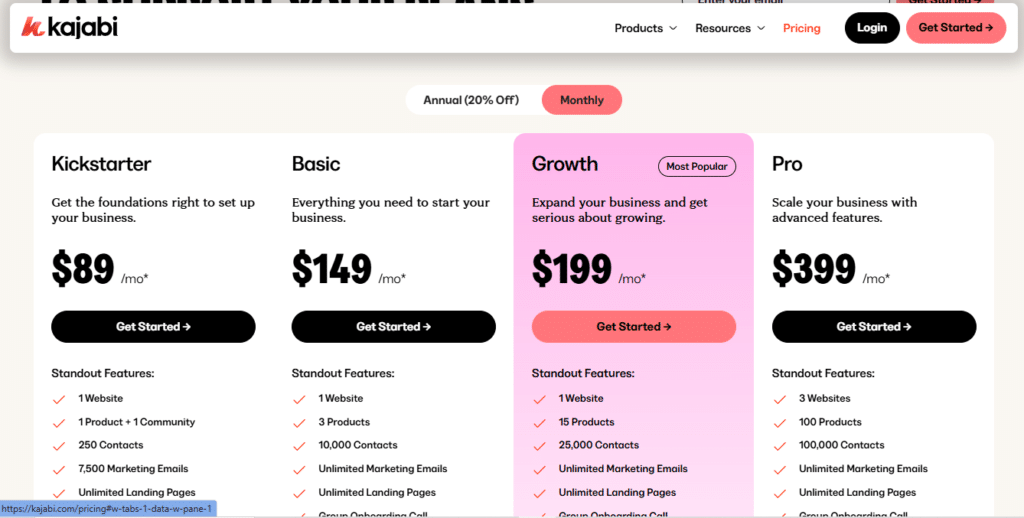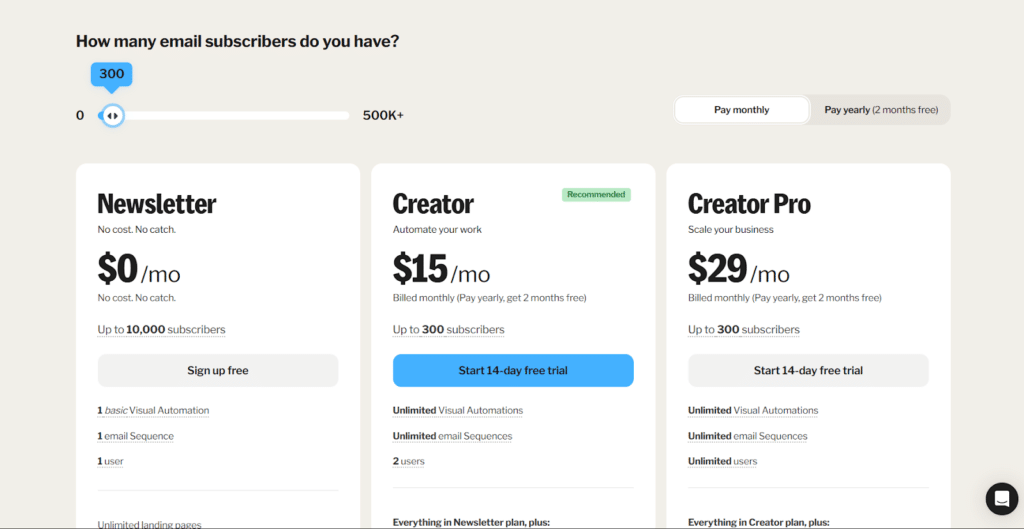Kajabi vs ConvertKit: A Comprehensive Platform Comparison
Choosing the right platform can make or break your online business. Whether you’re a course creator, coach, or community builder, the tools you use will directly impact your growth, engagement, and revenue.
Kajabi and ConvertKit are two powerhouse platforms, but they serve different purposes—Kajabi is an all-in-one business solution, while ConvertKit specializes in community-driven experiences.
So, which one is the best fit for you? In this in-depth comparison, we’ll break down their features, pricing, and ideal use cases to help you make an informed decision. Let’s dive in!
Overview of Kajabi

Kajabi is an all-in-one platform designed to help creators, entrepreneurs, and educators build and grow their online businesses. It simplifies the process of creating and selling digital products like courses, memberships, and coaching programs without requiring advanced technical expertise. With an intuitive interface, a variety of pre-built templates, and integrated marketing tools, Kajabi enables users to launch and scale their online businesses seamlessly. It is a complete solution for managing content, marketing, and customer engagement from a single platform.
Key Features of Kajabi
- Website Builder: Create fully functional websites with customizable templates and a drag-and-drop editor.
- Course Creation Tools: Design and deliver engaging online courses with multimedia capabilities.
- Email Marketing Automation: Build and manage email campaigns with automation to nurture leads effectively.
- Sales Pipelines: Access pre-built pipelines for launching products, hosting webinars, or offering free resources.
- Membership Sites: Set up and manage subscription-based content for recurring revenue.
- Payment Gateway Integration: Process payments securely with platforms like Stripe and PayPal.
- Analytics Dashboard: Monitor business performance, customer engagement, and sales metrics in real time.
Ideal User Base for Kajabi
- Course Creators: Looking to develop and sell online courses effortlessly.
- Coaches and Consultants: Offering training programs, webinars, or one-on-one coaching services.
- Membership Businesses: Seeking an all-in-one solution to create and manage subscription content.
- Digital Entrepreneurs: Who need a robust platform to scale their online businesses.
- Educators: Interested in sharing knowledge and building a thriving online teaching brand.
Overview of ConvertKit

ConvertKit is a user-friendly platform that empowers creators, entrepreneurs, and educators to build and sell online courses. Known for its simplicity and flexibility, ConvertKit provides a suite of tools to help users create, market, and deliver engaging learning experiences. With its robust customization options and integration capabilities, ConvertKit is well-suited for businesses of all sizes, enabling them to scale their operations with ease. The platform focuses on offering a seamless course-building experience while ensuring high-quality student engagement and learning outcomes.
Key Features of ConvertKit
- Course Builder: Create professional courses using an intuitive drag-and-drop interface and multimedia support.
- Website Customization: Build branded course websites with pre-designed templates and advanced customization options.
- Student Engagement Tools: Add quizzes, surveys, and discussion forums to enhance the learning experience.
- Payment Processing: Accept payments securely via Stripe, PayPal, or ConvertKit’s own payment gateway.
- Marketing Integrations: Connect with tools like Mailchimp, ActiveCampaign, or Zapier to manage leads and promotions effectively.
- Membership and Bundling Options: Offer subscription-based courses or bundle multiple products for added value.
- Advanced Reporting: Access detailed analytics to track student progress, sales performance, and course engagement.
Ideal User Base for ConvertKit
- Independent Course Creators: Individuals looking to share their expertise through professional courses.
- Small to Medium-Sized Businesses: Businesses aiming to train employees or customers with customizable learning solutions.
- Educational Institutions: Schools or colleges seeking a platform to deliver virtual learning experiences.
- Coaches and Trainers: Professionals offering group coaching or one-on-one training programs.
- Nonprofits and Organizations: Teams focused on community education or internal training initiatives.
Core Functionalities Comparison
When choosing between Kajabi and ConvertKit, understanding their core functionalities is essential to determine which platform best suits your needs. Here’s a breakdown of their primary features:
1. Course Creation and Delivery
- Kajabi: Offers an advanced course creation experience with options to include multimedia content, quizzes, assessments, and drip scheduling. It also allows you to bundle courses with other digital products, such as memberships and coaching programs.
- ConvertKit: Focused on simplicity, ConvertKit provides intuitive tools for creating courses with videos, quizzes, and downloadable files. It supports self-paced and scheduled learning but lacks the flexibility to bundle various product types like Kajabi.
2. Website Building
- Kajabi: Features a full-fledged website builder with customizable templates, a drag-and-drop editor, and integrated blogging capabilities. It’s ideal for users looking to build a branded online presence.
- ConvertKit: Offers basic customization for course landing pages, but its website-building functionality is limited compared to Kajabi. It works best for those prioritizing course delivery over creating a full website.
3. Marketing and Sales Tools
- Kajabi: Includes a robust suite of marketing tools, such as email campaigns, pre-built sales pipelines, automation, and upselling options. It is built to handle advanced marketing strategies without external integrations.
- ConvertKit: Provides basic marketing features, including affiliate marketing and coupon codes. However, users may need additional tools or integrations to execute advanced campaigns.
4. Payment Processing
- Kajabi: Supports multiple payment options, including one-time payments, subscriptions, and payment plans. It integrates with Stripe and PayPal seamlessly and doesn’t charge additional transaction fees.
- ConvertKit: Also integrates with Stripe and PayPal but charges transaction fees on its free and lower-tier plans unless you upgrade to the Pro plan.
5. Membership and Community Features
- Kajabi: Excels in offering membership capabilities, enabling users to create subscription-based communities and deliver exclusive content. It also includes community-building tools, like forums, within its platform.
- ConvertKit: Lacks native membership features, but you can sell recurring subscriptions for individual courses or bundles. Community features are minimal and require third-party integrations.
6. Analytics and Reporting
- Kajabi: Provides a comprehensive analytics dashboard, covering marketing performance, revenue, and customer engagement metrics. It’s suitable for tracking every aspect of your business.
- ConvertKit: Offers basic analytics to monitor course performance, sales, and student progress. However, its reporting features are less detailed than Kajabi’s.
Pricing Comparison: Kajabi vs ConvertKit
Here’s how Kajabi and ConvertKit compare when it comes to pricing:
Kajabi Pricing Plans

Kajabi offers a range of pricing tiers tailored to meet the needs of creators and businesses at different stages. Here’s a breakdown of their plans:
- Basic Plan ($149/month):
Designed for new creators, the Basic Plan allows a limited number of products and pipelines, making it ideal for those just starting with online course creation or digital products.
- Growth Plan ($199/month):
This mid-tier plan is perfect for growing businesses, offering an increased allowance for products, contacts, and marketing features like advanced automations.
- Pro Plan ($399/month):
The Pro Plan is tailored for established businesses with multiple products and a need for extensive marketing capabilities. It provides the highest level of resources, including custom branding options and priority support.
- Kickstarter Plan ($89/month):
Ideal for beginners, this budget-friendly plan is perfect for testing out Kajabi’s core functionalities without committing to higher-tier plans.
Kajabi’s pricing structure is flexible and depends on the number of products, pipelines, and contacts you manage. Higher tiers provide access to advanced tools and greater resource limits, making Kajabi a scalable platform for businesses of all sizes.
ConvertKit Pricing Plans

ConvertKit's pricing is primarily based on subscriber count, with two plan types:
Newsletter Plan (Free)
- Up to 1,000 subscribers
- Unlimited landing pages and forms
- Sell digital products and subscriptions
- Email broadcasts
- Community support
Creator Plan (Paid)
- $15/month for up to 1,000 subscribers (scales with subscriber count)
- Everything in Free plan
- Automated sequences
- Visual automation builder
- Third-party integrations
- Free migration from another tool
- Live chat support
Creator Pro Plan
- $29/month for up to 1,000 subscribers (scales with subscriber count)
- Everything in Creator plan
- Facebook custom audiences
- Newsletter referral system
- Subscriber scoring
- Advanced reporting
- Team members
- Priority support
ConvertKit's pricing increases as your subscriber list grows:
- 1,000 – 3,000 subscribers: $49/month for Creator, $79/month for Creator Pro
- 3,000 – 5,000 subscribers: $79/month for Creator, $109/month for Creator Pro
- 5,000 – 8,000 subscribers: $99/month for Creator, $129/month for Creator Pro
- And continuing to scale up
ConvertKit offers a 14-day free trial of paid plans and provides a free plan for up to 1,000 subscribers with limited features.
Making the Right Choice for Your Business
Choosing between Kajabi and ConvertKit ultimately depends on your business needs and goals. Kajabi is a comprehensive all-in-one platform, ideal for creators who want to manage everything—from courses to marketing—in one place. It’s particularly suited for those who need advanced tools like pipelines, automation, and detailed analytics.
On the other hand, ConvertKit focuses on simplicity and ease of use, making it a great choice for educators who prioritize course creation and delivery without needing extensive marketing features. It’s a budget-friendly option for beginners or businesses that don’t require advanced integrations.
Evaluate your budget, feature requirements, and growth plans to select the platform that aligns with your objectives. Both Kajabi and ConvertKit are powerful tools, but the right choice depends on what you value most in your business journey.